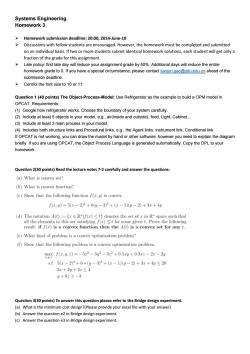上海交通大学:《Systems Engineering 系统工程》课程教学资源(作业)HW3

Systems Engineering Homework 3 >Homework submission deadline:20:00,2014-June-10 Discussions with fellow students are encouraged.However,the homework must be completed and submitted on an individual basis.If two or more students submit identical homework solutions,each student will get only a fraction of the grade for this assignment. Late policy:first late day will reduce your assignment grade by 50%.Additional days will reduce the entire homework grade to 0.If you have a special circumstance,please contact jianjun.gao@situ.edu.cn ahead of the submission deadline. >Control the font size to 10 or 11. Question 1(40 points)The Object-Process-Model:Use Refrigerator as the example to build a OPM model in OPCAT.Requirements: (1)Google how refrigerator works.Choose the boundary of your system carefully. (2)Include at least 5 objects in your model,e.g.,air(inside and outside),food,Light,Cabinet... (3)Include at least 3 main process in your model. (4)Includes both structure links and Procedural links,e.g.,the Agent links,instrument link,Conditional link If OPCAT is not working,you can draw the model by hand or other software,however you need to explain the diagram briefly.If you are using OPCAT,the Object Process Language is generated automatically.Copy the OPL to your homework. Question 2(30 points)Read the lecture notes 7-2 carefully and answer the questions: (a)What is convex set? (b)What is convex function? (c)Show that the following function f(,y)is convex. f(x,)=5(x-2)2+6(y-3)2+(x-1)(y-2)+3x+4y (d)The notation A(t):=fr E R"f(r)<t)denotes the set of x in R"space such that all the elements in this set satisfying f(r)<t for some given t.Prove the following result:if f(z)is a convex function then the A(t)is a convex set for any t. (e)What kind of problem is a convex optimization problem? (f)Show that the following problem is a convex optimization problem. mfz,4,)=-5x2-52-322+0.5ry+0.3r2-2x-2y 8.t.5(x-2)2+6*(y-3)2+(x-1)(y-2)+3x+4y≤20 2x+2y+2:≤4 y+62≥-3 Question 3(30 points)To answer this question please refer to the Bridge design experiment. (a)What is the minimum cost design?(Please provide your excel file with your answer) (b)Answer the question e2 in Bridge design experiment. (c)Answer the question e3 in Bridge design experiment
Systems Engineering Homework 3 Homework submission deadline: 20:00, 2014-June-10 Discussions with fellow students are encouraged. However, the homework must be completed and submitted on an individual basis. If two or more students submit identical homework solutions, each student will get only a fraction of the grade for this assignment. Late policy: first late day will reduce your assignment grade by 50%. Additional days will reduce the entire homework grade to 0. If you have a special circumstance, please contact jianjun.gao@sjtu.edu.cn ahead of the submission deadline. Control the font size to 10 or 11. Question 1 (40 points) The Object-Process-Model: Use Refrigerator as the example to build a OPM model in OPCAT. Requirements: (1) Google how refrigerator works. Choose the boundary of your system carefully. (2) Include at least 5 objects in your model, e.g., air(inside and outside), food, Light, Cabinet… (3) Include at least 3 main process in your model. (4) Includes both structure links and Procedural links, e.g., the Agent links, instrument link, Conditional link If OPCAT is not working, you can draw the model by hand or other software, however you need to explain the diagram briefly. If you are using OPCAT, the Object Process Language is generated automatically. Copy the OPL to your homework. Question 2(30 points) Read the lecture notes 7-2 carefully and answer the questions: Question 3(30 points) To answer this question please refer to the Bridge design experiment. (a) What is the minimum cost design?(Please provide your excel file with your answer) (b) Answer the question e2 in Bridge design experiment. (c) Answer the question e3 in Bridge design experiment
按次数下载不扣除下载券;
注册用户24小时内重复下载只扣除一次;
顺序:VIP每日次数-->可用次数-->下载券;
- 上海交通大学:《Systems Engineering 系统工程》课程教学资源(作业)HW2.pdf
- 上海交通大学:《Systems Engineering 系统工程》课程教学资源(作业)HW1.pdf
- 上海交通大学:《工程设计——产品设计与开发 Product Design and Development》课程教学资源(课件讲义,英文版)Chapter 10 Product Architecture.pdf
- 上海交通大学:《工程设计——产品设计与开发 Product Design and Development》课程教学资源(课件讲义,英文版)Chapter 08 Concept Selection.pdf
- 上海交通大学:《工程设计——产品设计与开发 Product Design and Development》课程教学资源(课件讲义,英文版)Chapter 06 Concept Generation.pdf
- 上海交通大学:《工程设计——产品设计与开发 Product Design and Development》课程教学资源(课件讲义,英文版)Chapter 05 Product Specifications.pdf
- 上海交通大学:《工程设计——产品设计与开发 Product Design and Development》课程教学资源(课件讲义,英文版)Chapter 04 Identifying Customer Needs.pdf
- 上海交通大学:《工程设计——产品设计与开发 Product Design and Development》课程教学资源(课件讲义,英文版)Chapter 03 Product Planning.pdf
- 上海交通大学:《工程设计——产品设计与开发 Product Design and Development》课程教学资源(课件讲义,英文版)Chapter 02 Development Processes and Organizations.pdf
- 上海交通大学:《工程设计——产品设计与开发 Product Design and Development》课程教学资源(课件讲义,英文版)Chapter 11 Design for Manufacturing.pdf
- 上海交通大学:《工程设计——产品设计与开发 Product Design and Development》课程教学资源(课件讲义,英文版)Chapter 01 Introduction.pdf
- 上海交通大学:《工程学导论》课程教学资源(讲义)Technical knowledge_Robotics.pdf
- 上海交通大学:《工程学导论》课程教学资源(讲义)Technical knowledge_Rapid Prototyping.pdf
- 上海交通大学:《工程学导论》课程教学资源(讲义)Technical knowledge_Quadruped Robots.pdf
- 上海交通大学:《工程学导论》课程教学资源(讲义)Technical knowledge_Metal cutting.pdf
- 上海交通大学:《工程学导论》课程教学资源(讲义)Technical knowledge_Machine Tools.pdf
- 上海交通大学:《工程学导论》课程教学资源(讲义)Technical knowledge_Machine Tools 2.pdf
- 上海交通大学:《工程学导论》课程教学资源(讲义)Technical knowledge_Introduction to Manufacutring.pdf
- 上海交通大学:《工程学导论》课程教学资源(讲义)Technical knowledge_How machine works.pdf
- 上海交通大学:《工程学导论》课程教学资源(讲义)Technical knowledge_Engine.pdf
- 上海交通大学:《Systems Engineering 系统工程》课程教学资源(作业)HW4.pdf
- 上海交通大学:《Systems Engineering 系统工程》课程教学资源(电子讲义)Course Experiment——Bridge Design.pdf
- 上海交通大学:《Systems Engineering 系统工程》课程教学资源(电子讲义)Lecture 11-1 Safety in Systems Engineering.pdf
- 上海交通大学:《Systems Engineering 系统工程》课程教学资源(电子讲义)Lecture 11-2 Systems Reliability Basics.pdf
- 上海交通大学:《Systems Engineering 系统工程》课程教学资源(电子讲义)Lecture 5 Systems Architecture.pdf
- 上海交通大学:《Systems Engineering 系统工程》课程教学资源(电子讲义)Lecture 9 Effective Innovation in Systems Engineering.pdf
- 上海交通大学:《Systems Engineering 系统工程》课程教学资源(电子讲义)Lecture1 Class Introduction.pdf
- 上海交通大学:《Systems Engineering 系统工程》课程教学资源(电子讲义)Lecture2 Landscape of SE.pdf
- 上海交通大学:《Systems Engineering 系统工程》课程教学资源(电子讲义)Lecture3 Stakeholder Requirements Definition.pdf
- 上海交通大学:《Systems Engineering 系统工程》课程教学资源(电子讲义)Lecture4 Technical Requirement Definition.pdf
- 上海交通大学:《Systems Engineering 系统工程》课程教学资源(电子讲义)Lecture6 Tradespace Exploration and Concept Selection:AHP Method.pdf
- 上海交通大学:《Systems Engineering 系统工程》课程教学资源(电子讲义)Lecture6 Tradespace Exploration and Concept Selection.pdf
- 上海交通大学:《Systems Engineering 系统工程》课程教学资源(电子讲义)Lecture7-1 Multidisciplinary System Design Optimization(MDO).pdf
- 上海交通大学:《Systems Engineering 系统工程》课程教学资源(电子讲义)Lecture7-2 Multi-Objective Optimization.pdf
- 上海交通大学:《Systems Engineering 系统工程》课程教学资源(电子讲义)Lecture8-1 System Integration and Interface management 1-DSM.pdf
- 上海交通大学:《Systems Engineering 系统工程》课程教学资源(电子讲义)Lecture8-2 System Integration and Interface management 2 Axiomatic Design.pdf
- 《Systems Engineering 系统工程》课程教学资源:OPCAT Version 3.0 Getting Started Guide.pdf
- 《Systems Engineering 系统工程》课程教学资源(阅读文献)UNDERSTANDING THE ORBITAL TRANSFER VEHICLE TRADE SPACE.pdf
- 《Systems Engineering 系统工程》课程教学资源(阅读文献)How to Set Swing weighting - DDL Wiki.pdf
- 《Systems Engineering 系统工程》课程教学资源(阅读文献)Definition, Expansion and Screening of Architectures for Planetary Exploration Class Nuclear Electric Propulsion and Power Systems.pdf
